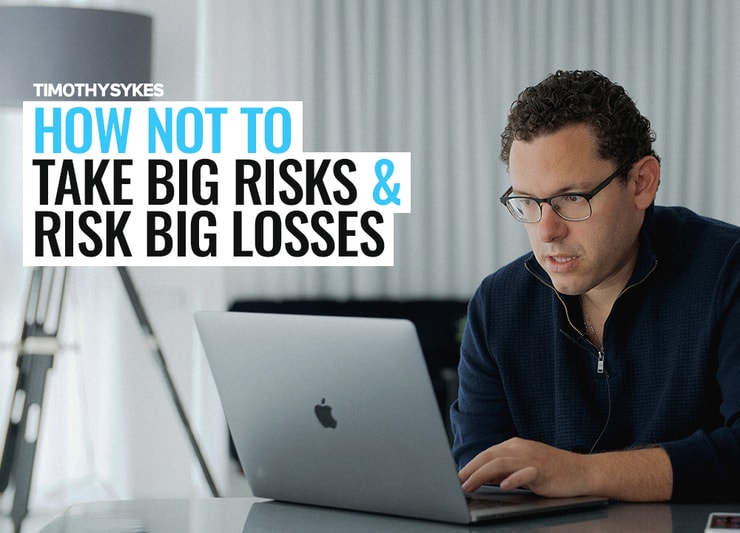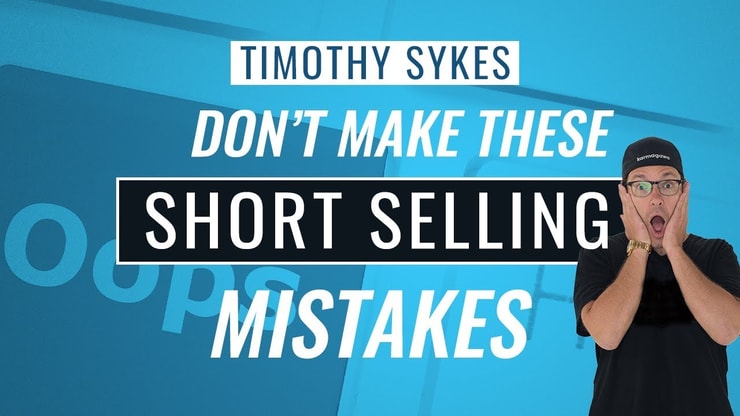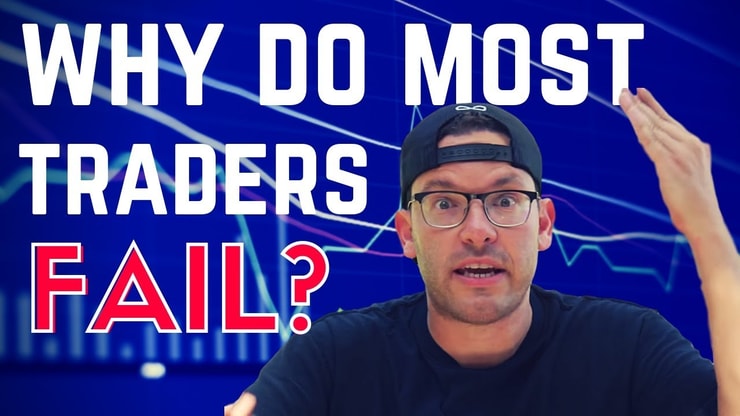A big part of being a self-sufficient trader is learning how to not take big risks.
You have to learn to recognize big risks and you have to know when to cut losses. Rule #1 is to cut losses quickly. But with some of these plays, you can’t always do that.
My goal is to help you stay safe. Right now, I see way too many students engaging in risky trading strategies.
This is where it gets interesting from a teaching standpoint. There are strategies you can use to try to make money. But they often come with the risk of decimating your account. And that can happen with just one trade…
I just don’t think it’s worth it. And it’s my job to teach you everything I’ve learned in my 20+ years of trading. I want to help you learn to trade safer and smarter.
So let’s get into how to limit your risks when trading…
Table of Contents
Know the Risks of Short Selling

I’ve said this a million times: I don’t recommend short selling for new traders.
First of all, shorting opens you up to the risk of losing your entire account. Say you’re shorting a stock and it goes against you. And you don’t — or can’t — cut losses … You could lose the money you put into the trade AND your entire account.
Even worse, you can end up owing your broker by the time you get out.
Shorting low-float stocks on a Friday morning in a hot sector is especially risky. Low floats can spike super fast, so it can be hard to cut losses quickly.
None of my students should get into this kind of risky trade. It goes against everything I teach.
But there are still too many students taking these risky positions. Maybe they get lucky and have a few wins. And that leads them to mistakenly believe they’re on the right track. But in reality, they’re risking their entire account and more.
That’s why I say short sellers are the new promoters. They’re not telling people the whole story. They don’t lay out all the risks.
Short sellers can have decent wins over time. Some may have 5%–10% gains and win 60%–80% of the time. That’s not that far off from my record (check out every trade I make on Profit.ly).
But it just takes one wrong trade to blow up. You risk losing everything and more. That’s the problem with shorting. And too many people don’t understand that. With one trade, you can wipe out months, or years, of gains.
When you’re a new trader, you should focus on the process and following the rules. Take only the best setups. Develop good trading habits.
You also gotta…
Recognize When You’re Being Stubborn
You have to recognize when you’re being stubborn. This can happen to traders on the long side and the short side.
But there’s a key difference in terms of risk. When I long stocks, I don’t risk all my money. I don’t even risk a big percentage. When you short, your risk can be exponential — no matter your position size. You don’t know how high these stocks can go. More on that in a bit.
Losses are part of trading. You’ll never be right 100% of the time. Even I still make mistakes and take losses. But I always cut losses quickly.
New traders tend to take positions and they don’t even know why. Sometimes they trade just for the sake of doing it. Sometimes they’re revenge trading.
It’s the wrong mindset, and it’s not trading with a strategy or plan. And when those trades go against them, they don’t want to admit they’re wrong and take a loss. They start to hold and hope.
Don’t be so stubborn that you blow up your account. Learn how to cope with your losses. It blows my mind how cocky some new traders are. They can open themselves up to unlimited losses. Especially on the short side.
You might think it won’t happen to you, but it can. Even my top student Tim Gritanni admits that his biggest six-figure loss was on a short position. Guess what happened … Yep, he got stubborn and didn’t cut losses.
That brings me to…
The Most Dangerous Trade
Recently, during a Trading Challenge webinar, a student was shorting a low-float hot sector stock on a Friday morning. This student was asking everyone in the chat room if they agreed with the position. Nope!
I would never short a hot sector play on a Friday morning. It’s like asking to be punished.
This play went against all my rules. Grittani was actually long in the same stock.
Here’s the thing…
You can be trading a small position … And you can back it up with a solid trading record … You might even argue that you’ll cut losses quickly…
The problem is, if the play breaks out big, you can’t always cut losses quickly.
In a hot sector, news can drop at any time. A single press release can spike the stock.
Any news can bring more buyers to the stock and create a massive spike. Or the SEC could halt it, and then it re-opens higher. That makes it impossible to cut losses. There are just too many things you can’t predict.
I don’t want to see any of my students in a position where they lose big. If you have to argue about your position to justify it to yourself and others, it’s probably not a good trade.
The point is, even if you’re trading small size, why take the risk? Why waste your time with low-odds setups? You’re only creating bad habits.
Shorting a play like this is way too risky. There are better plays out there where you’re not risking losing your entire account.
Retweet/favorite this ONLY if you promise to be fucken disciplined when the markets reopen tomorrow, gamblers blow up so do better!
— Timothy Sykes (@timothysykes) February 10, 2020
The Power of the Short Squeeze
Remember the most recent epic short squeeze, BPTH? So many traders lost everything and blew up their accounts shorting it. Even experienced traders were exposed to the risk. The stock went from the $8s to the low $70s in two days.
I say it all the time: Shorting is dangerous … especially in this market. And newbies tend to judge their trading by how much money they make. If they make money, they think it’s a good trade. But they don’t consider what can go wrong.
That’s where I come in and try to educate them on all the possibilities. I use my experience to try to help them. I want my students to trade safe. But some people don’t want to hear it. They think as long as they’re making money they don’t need to learn anything else.
Learn From Former Epic Short Squeezes
The past doesn’t always repeat itself, but it often rhymes. This is why you study the past. And there have been some HUGE short squeezes in the past. These are good examples of the kinds of losses I want you to avoid.
AQXP is another example. It’s since gone private or changed its ticker. The stock traded between $5–$10. Then it struggled in the $10 range — shorts were likely loading up. The next day, it opened at $18 and rocketed to the $50s.
Then there’s KBIO. My student Michael Goode and I were both on the wrong side of KBIO the night it started spiking after hours. But we cut losses quickly when it went against us. It went from $1 to $10 that night … And the next day it was up to $20.
The most epic short squeeze of all has to be DRYS. In 2016, the stock went from the $5s to the $120s in just five days. That’s an increase of 1,800%. The SEC eventually halted it in the $120s. Otherwise, it probably would’ve gone higher.
These are just a few of the biggest short squeeze examples. There are so many more. Can your account withstand that kind of loss?
The problem with a lot of short-sellers is that they just keep adding to their positions. The stock goes higher, and they just keep adding. They think that when the stock finally declines they’ll make bank…
But what if you’re down too much and your broker buys you in? You have no choice. You’re out of your position and you’re stuck with the loss — no matter how big.
Shorting is the only strategy where you can lose 10–30 times your money — or more — in minutes or days. And it’s not just new traders, experienced traders lose big on these too.
Prioritize Safety

As a trader, your goal should be to protect your account at all costs. When a trade goes against you, cut losses quickly. I try to drill this into all my students.
But sometimes I come down too hard. And for that, I apologize. I know I can be a jerk sometimes. But I’d rather have people be mad at me than watch them lose money.
If I was nicer, people wouldn’t listen to me. I’d probably see a lot more blow-ups. I don’t want that on my conscience. And a lot of students actually like my drill sergeant attitude. If I wasn’t passionate about my teaching, a lot of people wouldn’t listen to me.
Thing is, I REALLY prioritize safety. You can call me a lot of things, but you can’t call me an unsafe trader. I just want my students to trade safely.
Short sellers might have the same winning percentage as me, but I’m playing safe. I’m going long. I’m dip-buying multi-day runners. And buying multi-day breakouts.
The best plays don’t come around every day, so trade like a sniper. And it’s OK to miss a trade. There will be more opportunities. But you gotta be smart about how you trade.
Follow the Rules
Too many newbies have the wrong mindset. They wanna be told what to buy, when to buy, and when to sell. I have to deprogram a lot of my students and teach them how to think for themselves.
That’s why I promote studying so much. I want you to be self-sufficient and know the risks.
You have to look at why a stock is doing something. Don’t just dip buy any stock. You need to have a reason. Why is the stock dipping? You have to understand why a stock is moving.
Don’t trade just for the sake of trading. A stock might fail on a Friday morning, but that doesn’t mean it’s an opportunity to short. So many traders are just looking for quick cash. But when you do that, you risk too much.
This isn’t rocket science. But you need to think about multiple indicators and the potential risks. It’s not easy. It takes practice. But it gets easier with experience and if you stick to the rules. If I don’t see truly great plays, I don’t trade.
Conclusion
Let’s review the basic rules you can use to protect your account and trade safely.
I teach students to look for big percent gainers with a catalyst. Use StocksToTrade because the built-in scans include everything you need. They were designed based on my criteria. Everything is right there — percent gainers, news, the social media search tool…
Why do people keep asking me about all these other platforms and news providers? StocksToTrade is specifically designed for low-priced stocks — use it.
Focus on only the best plays. Watch the overall market. Remember, three out of four stocks follow the market. If the markets are down and you’re looking to buy, you may not find your A+ setup.
If you don’t know what an A+ setup is, study the video lessons and DVDs until you do. They can help you build a foundation of knowledge that you expand on with time and experience.
I suggest you start with “Trader Checklist Part Deux” to learn the seven trading indicators. Looking for more specifics on what’s happening in the markets now? Check out my four-part series. I look at short squeezes, hot biotechs, former runners, and hot OTCs.
What do you think of this post? Let me know in the comments … I love to hear from you!







Leave a reply